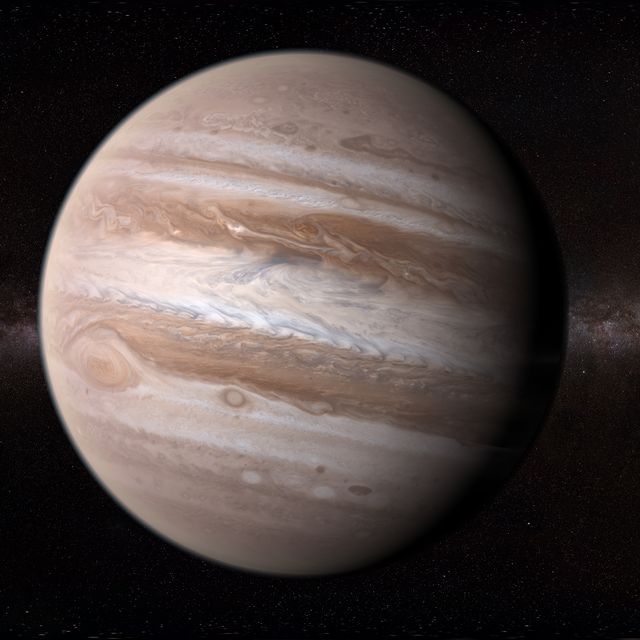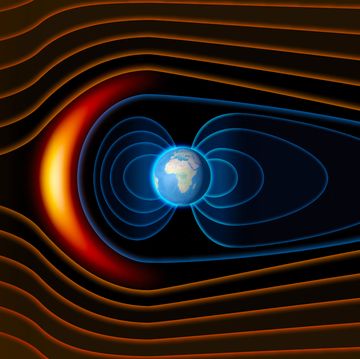- Jupiter and Earth may be an odd couple, but both have atmospheres and global magnetic fields.
- In new research, scientists use an atmospheric current to narrow down Jupiter’s core mystery.
- We measure magnetic fields with an instrument distantly related to a regular compass.
Jupiter is a bright enigma in our Solar System, with 2.5 times the mass of all the other planets combined, the oldest age by far, and a composition that some argue is closer to a star than a planet. Now, researchers from Harvard University have used NASA’s Juno spacecraft to identify a cyclical change in Jupiter’s atmosphere. It turns out things are getting all scrambled up in the jet stream, and the core may be at fault. Their research appears in Nature.
The team examined Jupiter’s magnetic field, including a locus of magnetic activity called the Great Blue Spot. By looking at the outer magnetic field like a projection, scientists can try to backtrace what’s going on inside Jupiter’s mysterious metal core. In this case, they observed a powerful atmospheric current—like Earth's jet stream on steroids—which is disrupted by core activity.
The Juno spacecraft—named for Jupiter’s wife in ancient Roman mythology—is the latest generation to map Jupiter’s magnetic field using a magnetometer. This, in a way, is a version of a compass that gauges magnetic field strength and direction by measuring how much it affects a charged metal object. (You might call magnetic nail polish a primitive magnetometer. Metallic car paint can also be affected by magnets in this way.) Over the decades, Pioneer 10 and 11, Voyager 1, Ulysses, and now Juno have all mapped Jupiter’s magnetic field using contemporary magnetometer technology.
By comparing the maps, scientists were able to trace a change in the Great Blue Spot. This magnetic “hot spot,” proverbially speaking, is so named for its blue color in computer-generated maps based on magnetometer measurements. And like Earth’s magnetic field, the Great Blue Spot is drifting. In this new paper, researchers led by Harvard geophysicist Jeremy Bloxham highlight the way one powerful atmospheric current around Jupiter’s equator is fluctuating in a four-year cycle. The current gets especially scrambled in the Great Blue Spot.
Though Jupiter is very different from Earth—and much, much larger—the two planets have a couple of vital things in common. First, Jupiter and Earth both have jet streams (along with a handful of other planets), because they have significant atmospheres. And second, they both have global magnetic fields generated by activity in their core, an explanation referred to as dynamo theory.
That means we can use information about Earth’s core and magnetic field in order to better understand this new research about Jupiter. Earth’s core is partly liquid and partly solid, and the physical phenomena happening inside the core combine with Earth’s rotation to create an electromagnetic effect. We can study Earth’s core from outside because we live here, but no one has witnessed Earth’s core directly.
And if we can't even get to our own core, directly investigating Jupiter’s is pretty much a non-starter. We won’t ever be able to land a spacecraft on Jupiter—though, in some far future schema, there might be a way to rig long-term sensors. The iconic science fiction author Arthur C. Clarke famously gave Jupiter a core of diamond in 1982, but the real thing is limited to hydrogen and helium. Scientists now believe Jupiter’s core is partly made of liquid hydrogen that’s deformed into a conductive state by the extreme pressure.
They’re also pretty comfortable saying that Jupiter’s magnetic field resembles the others explained by dynamo theory. By studying Jupiter’s scrambled jet stream, Bloxham and his team pinned down its time cycle to four years. With this regular time period in place, they can try to solve for other variables, like the shape of the wave in the planet’s core that induces the fluctuation. Think about the ribbon held by a rhythmic gymnast, which holds a shape like a wave or a cylinder as it flies through the air. The jet stream fluctuation is very likely to be one of two shapes, narrowing down an otherwise much more open field.
“This opens a pathway towards revealing otherwise hidden aspects of the magnetic field within the metallic hydrogen region and hence constraining the dynamo that generates Jupiter’s magnetic field,” the team explains in the paper. In other words, the type of fluctuation can be used to make new hypotheses about Jupiter’s core processes, and those can be tested using current and future data. Are liquid hydrogen waves scrambling this jet stream?
The magnetometer has been used in some form since its invention—nearly 200 years ago, in 1833. Despite all that time passing, we’re still constantly surprised and puzzled by Earth’s magnetic field, which drifts, wobbles, and even switches magnetic poles periodically. For those in the Jupiter business, this research is an exciting step forward in understanding its magnetic field, too—and a sign that business is booming.

Caroline Delbert is a writer, avid reader, and contributing editor at Pop Mech. She's also an enthusiast of just about everything. Her favorite topics include nuclear energy, cosmology, math of everyday things, and the philosophy of it all.













